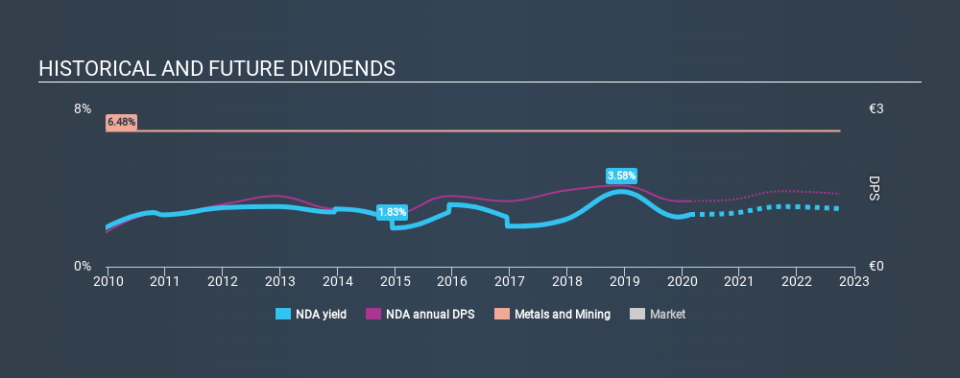Aurubis AG (ETR:NDA)'s Could Be A Buy For Its Upcoming Dividend

Readers hoping to buy Aurubis AG (ETR:NDA) for its dividend will need to make their move shortly, as the stock is about to trade ex-dividend. You can purchase shares before the 28th of February in order to receive the dividend, which the company will pay on the 3rd of March.
Aurubis's next dividend payment will be €1.25 per share. Last year, in total, the company distributed €1.25 to shareholders. Based on the last year's worth of payments, Aurubis has a trailing yield of 2.5% on the current stock price of €50.24. If you buy this business for its dividend, you should have an idea of whether Aurubis's dividend is reliable and sustainable. So we need to investigate whether Aurubis can afford its dividend, and if the dividend could grow.
See our latest analysis for Aurubis
Dividends are usually paid out of company profits, so if a company pays out more than it earned then its dividend is usually at greater risk of being cut. Aurubis is paying out just 22% of its profit after tax, which is comfortably low and leaves plenty of breathing room in the case of adverse events. Yet cash flow is typically more important than profit for assessing dividend sustainability, so we should always check if the company generated enough cash to afford its dividend. Fortunately, it paid out only 28% of its free cash flow in the past year.
It's encouraging to see that the dividend is covered by both profit and cash flow. This generally suggests the dividend is sustainable, as long as earnings don't drop precipitously.
Click here to see the company's payout ratio, plus analyst estimates of its future dividends.
Have Earnings And Dividends Been Growing?
Businesses with strong growth prospects usually make the best dividend payers, because it's easier to grow dividends when earnings per share are improving. If earnings decline and the company is forced to cut its dividend, investors could watch the value of their investment go up in smoke. That's why it's comforting to see Aurubis's earnings have been skyrocketing, up 43% per annum for the past five years. Earnings per share have been growing very quickly, and the company is paying out a relatively low percentage of its profit and cash flow. This is a very favourable combination that can often lead to the dividend multiplying over the long term, if earnings grow and the company pays out a higher percentage of its earnings.
Another key way to measure a company's dividend prospects is by measuring its historical rate of dividend growth. Aurubis has delivered an average of 6.8% per year annual increase in its dividend, based on the past ten years of dividend payments. We're glad to see dividends rising alongside earnings over a number of years, which may be a sign the company intends to share the growth with shareholders.
The Bottom Line
Is Aurubis an attractive dividend stock, or better left on the shelf? Aurubis has been growing earnings at a rapid rate, and has a conservatively low payout ratio, implying that it is reinvesting heavily in its business; a sterling combination. There's a lot to like about Aurubis, and we would prioritise taking a closer look at it.
Curious what other investors think of Aurubis? See what analysts are forecasting, with this visualisation of its historical and future estimated earnings and cash flow.
We wouldn't recommend just buying the first dividend stock you see, though. Here's a list of interesting dividend stocks with a greater than 2% yield and an upcoming dividend.
If you spot an error that warrants correction, please contact the editor at editorial-team@simplywallst.com. This article by Simply Wall St is general in nature. It does not constitute a recommendation to buy or sell any stock, and does not take account of your objectives, or your financial situation. Simply Wall St has no position in the stocks mentioned.
We aim to bring you long-term focused research analysis driven by fundamental data. Note that our analysis may not factor in the latest price-sensitive company announcements or qualitative material. Thank you for reading.


